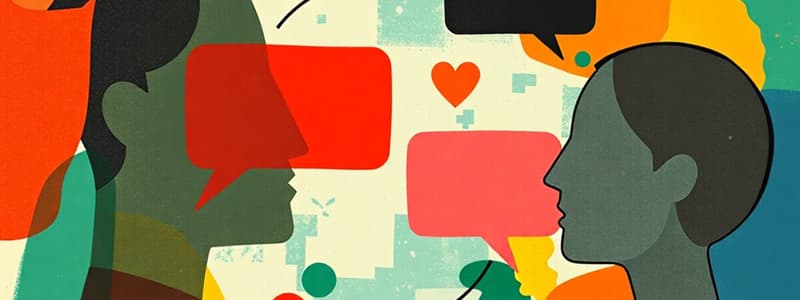Podcast
Questions and Answers
What is a necessary component for communication to be considered successful?
What is a necessary component for communication to be considered successful?
- A message being transferred
- Presence of non-verbal cues
- Use of technology
- Both parties having some common signs (correct)
Which of the following definitions encompasses the broader understanding of communication?
Which of the following definitions encompasses the broader understanding of communication?
- Deep understanding of cultural symbols in messages
- Verbal communication only
- Exchange of messages ensuring full understanding
- Transmitting information without the need for understanding (correct)
How is communication defined in relation to responses?
How is communication defined in relation to responses?
- A two-way process that yields a response (correct)
- A process of sharing without any feedback
- An exchange of information that requires technology
- A one-way conveyance of information
What aspect of communication is emphasized by Ivansevich and Matteson?
What aspect of communication is emphasized by Ivansevich and Matteson?
What is the primary characteristic of ideal communication?
What is the primary characteristic of ideal communication?
What is indicated as a crucial aspect that enhances communication?
What is indicated as a crucial aspect that enhances communication?
Which goal focuses on how individuals wish to be perceived by others?
Which goal focuses on how individuals wish to be perceived by others?
In the context of communication, what is a transmitter?
In the context of communication, what is a transmitter?
Which of the following best describes the overall nature of communication?
Which of the following best describes the overall nature of communication?
What type of messages does communication encompass?
What type of messages does communication encompass?
What type of communication goal involves managing interpersonal conflicts?
What type of communication goal involves managing interpersonal conflicts?
What happens when communication does not achieve full understanding?
What happens when communication does not achieve full understanding?
What does the signal in communication refer to?
What does the signal in communication refer to?
Which of the following describes how sound and gestures function in face-to-face communication?
Which of the following describes how sound and gestures function in face-to-face communication?
Which goal is primarily concerned with the development and maintenance of relationships?
Which goal is primarily concerned with the development and maintenance of relationships?
What are anchoring and contrast effects examples of?
What are anchoring and contrast effects examples of?
What is a consequence of using incorrect language in communication?
What is a consequence of using incorrect language in communication?
Why is it important to check the spelling of names?
Why is it important to check the spelling of names?
What distinguishes intentional communication from unintentional communication?
What distinguishes intentional communication from unintentional communication?
How should technical terms be used in communication?
How should technical terms be used in communication?
What leads to confusion in communication?
What leads to confusion in communication?
How does communication promote socialization among humans?
How does communication promote socialization among humans?
What is the effect of poor appearance in a document?
What is the effect of poor appearance in a document?
What role do verbal and non-verbal cues play in communication?
What role do verbal and non-verbal cues play in communication?
Which of the following is crucial for the clarity of a message?
Which of the following is crucial for the clarity of a message?
What is the first step in the communication process?
What is the first step in the communication process?
What is a recommended practice to avoid confusion in sentences?
What is a recommended practice to avoid confusion in sentences?
Which of the following is NOT a factor influencing ideation in the communication process?
Which of the following is NOT a factor influencing ideation in the communication process?
What is a key characteristic of the communication process?
What is a key characteristic of the communication process?
What is important about the tone, formality, and style of communication?
What is important about the tone, formality, and style of communication?
Which of the following notes the relationship between communication and misunderstandings?
Which of the following notes the relationship between communication and misunderstandings?
What is the outcome when proper verbal and non-verbal cues are employed in communication?
What is the outcome when proper verbal and non-verbal cues are employed in communication?
What is the primary purpose of using proper punctuation in sentences?
What is the primary purpose of using proper punctuation in sentences?
How can consistency be achieved in writing?
How can consistency be achieved in writing?
What describes coherence in writing?
What describes coherence in writing?
What is the significance of concreteness in communication?
What is the significance of concreteness in communication?
Which of the following exemplifies conciseness in writing?
Which of the following exemplifies conciseness in writing?
Which phrase represents a vague expression that should be avoided for clarity?
Which phrase represents a vague expression that should be avoided for clarity?
What does it mean to reduce unimportant ideas to phrases or single words?
What does it mean to reduce unimportant ideas to phrases or single words?
Which of the following phrases is an example of unnecessary modifiers?
Which of the following phrases is an example of unnecessary modifiers?
Flashcards are hidden until you start studying
Study Notes
Communication Overview
- Communication is the exchange of messages or information between a sender and a receiver.
- Effective communication requires shared language, signs, or signals to ensure understanding.
- Communication can be verbal (spoken/written) and non-verbal (body language, gestures).
Types of Communication
- Intentional Communication: Deliberate messaging aimed at achieving specific outcomes.
- Unintentional Communication: Inadvertent messages conveyed through misuse of verbal and non-verbal cues.
Goals of Communication
- Self-Presentation Goals: Conveying identity and perception.
- Relational Goals: Managing relationships (development, maintenance, termination).
- Instrumental Goals: Influencing others, achieving compliance, or resolving conflict.
Process of Communication
- Communication is a structured, two-way process involving ideation, message encoding, transmission, decoding, and feedback.
Steps of Communication
- Ideation: The sender generates thoughts that form the basis of the message.
- Clarity: Messages must be straightforward to avoid misunderstandings.
- Consistency: Standardization in language, spelling, and formats is crucial for coherence.
- Coherence: Logical arrangement of ideas aids in comprehension.
- Concreteness: Use of specific details and examples enhances clarity.
- Conciseness: Communication should be succinct, avoiding unnecessary words.
Importance of Communication
- Promotes socialization and fosters interpersonal connections.
- Reduces misunderstandings when verbal and non-verbal cues are effectively used.
Elements of Communication
- Information Source: The originator of the message.
- Message: The content being communicated.
- Transmitter: The medium or instrument (e.g., phone, body language) used to send the message.
- Signal: The actual data transmitted through the chosen channel.
Encoding and Decoding
- The sender encodes thoughts into a message using language and context.
- The receiver decodes received messages, seeking to understand and provide feedback.
Barriers to Effective Communication
- Poor clarity due to complex language or jargon can hinder understanding.
- Inconsistent formatting and ambiguity may lead to misinterpretation.
- Ineffective body language or misaligned non-verbal cues can cause confusion.
Communication in Practice
- Use clear, simple language and short sentences to enhance understanding.
- Maintain a neat, professional appearance in written and spoken communication.
- Seek feedback to clarify messages and ensure mutual understanding.
Studying That Suits You
Use AI to generate personalized quizzes and flashcards to suit your learning preferences.




